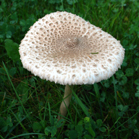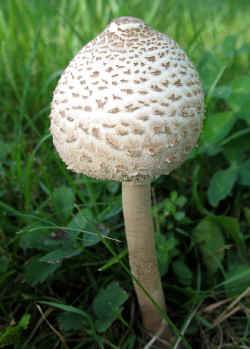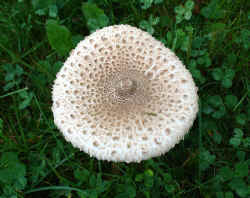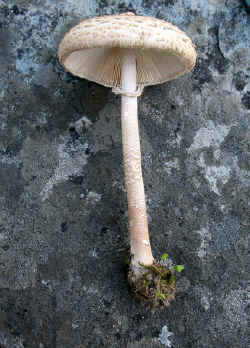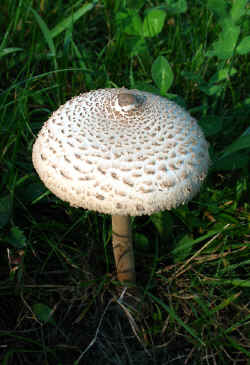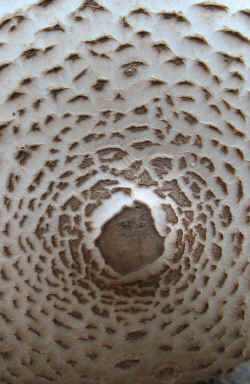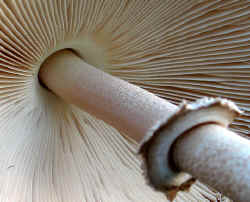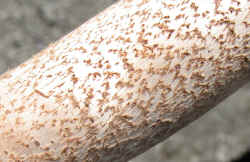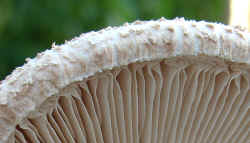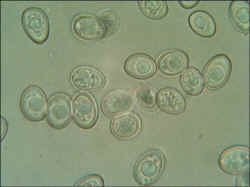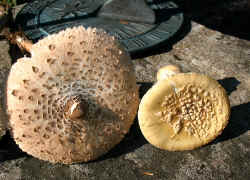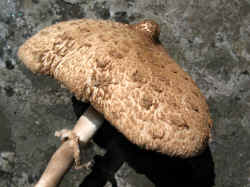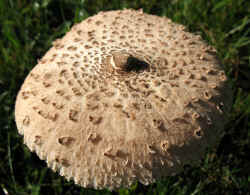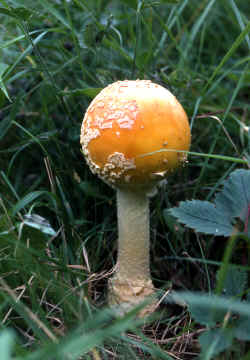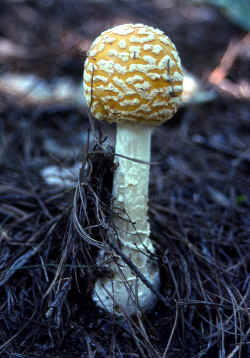|
|
A New England and Eastern Canada Edible and Medicinal Mushroom Resource |
|||
|
Parasol Mushroom
I have wrestled quite a bit over whether to add this one. The Parasol Mushroom/Lepiota (Macrolepiota procera) may be a better one for intermediate and advanced collectors. They have exceptionally fine flavor though. One of the absolute best. Although it is not that hard to identify you must be exceptionally observant of all characteristics. You cannot afford a mistake. There are some Lepiota relatives that are very poisonous or even deadly. You also cannot make the mistake of collecting an amanita! Amanitas can also be poisonous or deadly. Be sure to consult your field guides and if possible check with a local expert. Always make a spore print! Never eat small Lepiotas or any with green aspects to the gills or a green spore print. Comments made here cannot be applied to west coast Lepiotas where there are many more species. Fruit body Parasols have a broad, scaly, brownish cap with a bulbous based, tall, scaly, brownish stem with a movable ring. Cap (pileus) Ovate (egg shaped) becoming bell shaped then nearly flat. 3-10 inches wide with attached scales in a regular pattern and a central knob that is brown at first but cracks with age revealing the white flesh. A mature cap may smell of maple syrup. Gills (lamellae) Broad, rough edged, white, close, free gills. Stem (stipe) 3-12 or more inches tall. 3/8-5/8 inches thick. Enlarged to bulbous at the base with brown scales that have a pattern somewhat resembling herringbone The partial veil becomes a ring that slides up and down the stem. Flesh White and moderately thick and non bruising. Spores White spore print. When and where to find them The Parasol Mushroom may be found on lawns, trail or woods edges, and in the woods. They may or may not be near trees although the can have a preference for certain trees. Oak or white pine or other conifers are good places to look but they can be in any mixed woods. Large specimens are often found on lawns sometimes in large numbers and may be as much as a foot tall. Preparation This is a really great tasting mushroom! The mature caps can have the odor and taste of maple syrup. The maple character seems to become more pronounced if it dries just slightly. They are wonderful sautéed/pan fried or tempura fried. They are best served alone or in a way that showcases their outstanding flavor such as a soup or mild sauce. The stems are often discarded as they are tough and fibrous. I suspect they might be used as a duxelles if very finely chopped. I haven't found enough of them to do as much experimentation as I would like. They just keep disappearing. Comments You should be sure to eat just a bit at first to be sure you have no reaction. Never ever eat real small Lepiotas or any with any hint of green gills or a green spore print like Chlorophyllum molybdites (link below). Chlorophyllum molybdites can grow in similar locations and bear a passing resemblance. It only shows greenish gills with age, otherwise white. You can't take chances with this one. Be sure! Consulting a mycologist or experienced mushroomer is always a good idea. You might have luck with making a slurry for propagating parasols in your lawn by placing your older or wormy caps in water for a day or so to capture the spores in solution then pouring the water on your lawn Of course you don't use weed killer on your lawn! Other edible larger size relatives are the Reddening Lepiota, (Lepiota americana/Leucoagaricus americanus) and the Shaggy Parasol (Lepiota/Chlorophyllum rachodes) that are not treated here. Chlorophyllum molybdites at MushroomExpert.com
|
